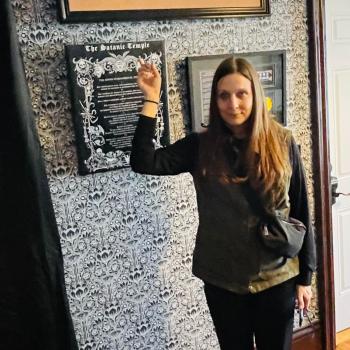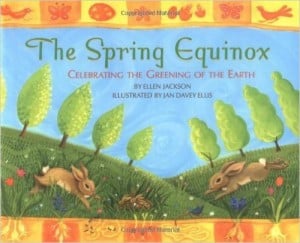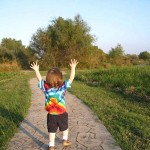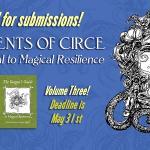I lie awake in the dark with my children beside me, one on each side. The little one snuggles with her whole body, the big one with just an outstretched hand. I remember when she followed me in her sleep like a sunflower follows the sun; now when she does that, it usually means she needs another blanket.
As I write this, I’m starting the slow process of night-weaning my second child, and it’s gotten me thinking on how we sleep. I’ve done little sleep training, since it’s easier to change my own sleep habits than my children’s. If they need help getting back to sleep, I help, and slowly the kids have absorbed the idea that nights are for sleep. But in the meantime, they’ve taken me into ancient rhythms of waking and sleeping. It’s been over five years since I’ve “slept the night,” and as awful as that might sound to new parents, I’m looking back on those nights with a sense of gratitude.
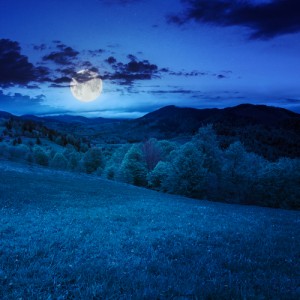
When I take the long view toward my last five years of nights, what I see is a spiritual practice that unfolded without being put on a to-do list, without me even knowing to look for it. It grew of its own accord, same as the children. Somewhere between the moments of pregnant insomnia, between lullabies and guided meditations, sore hips and flashes of anger, my understanding of night time changed. Instead of sleeping in a calculated, efficient way and asking my time in bed to disappear in the darkness, now I travel through troughs of dreams and crests of wakefulness. Wakefulness complements dreaming like a hill complements a valley, and so I’ve found myself in a topography full of vistas.
It shouldn’t surprise me. This intermittent approach to sleep is hardly new, nor is using it for spiritual ends. When artificial light was scarce, people went to bed earlier than they do now, but that doesn’t mean they slept all night. Historian A. Roger Ekirch’s survey of texts from pre-modern Europe shows that for centuries, nighttime sleep was divided into two main segments, separated by a watching hour in the early AM. During that hour of the night, people would talk with their bedmates, pray, get sexy, contemplate dreams, smoke, steal fruit from their neighbors’ trees, and–I presume–nurse their babies. Anthropologists have observed similar sleep patterns among some contemporary traditional cultures. And Thomas Wehr, who pioneered studies of circadian rhythms, found that contemporary Americans sleep bimodally, too, if they don’t have access to artificial light.
In addition to the watching hour, people in traditional cultures also woke up more often due to minor disruptions and discomforts. Historically we’ve slept together in groups, had more babies, and slept with those babies in those groups–you can do the math there yourself, and then throw in more fleas. Sleeping the night is a modern Western invention, not the inevitable result of maturity. People with more traditional sleep patterns weren’t chronically exhausted as a result (though they also typically took naps), and unlike modern Americans, they generally spoke positively of waking up in the middle of the night. Other studies suggest a biological basis for why people considered the watching hour so cozy and pleasant: early morning brings a daily high tide of prolactin, the same hormone that leads to milk production and post-orgasmic satisfaction, among other things. It facilitates a calm which is good for getting perspective on our lives and letting go of old anxieties.
This is the unexpected vantage point that I’ve landed at by going to bed early and going along with my kids’ predilection to wake up at night: I benefit from keeping a watching hour, too, even when I’m soothing a baby or toddler back to sleep. In my experience, time awake at night is not always fun, but sometimes it’s indispensable. Especially in the early winter, when days are busier than usual and full of to-do lists, I need space in the dark. And when I need that space, I inevitably find myself waking up to fill it.
At first I tended to write in my head when I woke up. I stayed awake for hours sometimes, repeating the same magic phrases, and excused myself by supposing that it would help me write more quickly once I got to a computer. Except it didn’t, and over time I noticed that much of what I was writing in my head at night sounded defensive and stuck. I also noticed that thinking in words takes me out of the dark and toward daytime consciousness, which is useless at night when you’re snuggled between people. So I started moving away from the modern sense that the hours of the day are ideally interchangeable, toward seeing night as having its own character and own ways of thinking.

Now I hold the watching hour as a sabbath from making mental to-do lists. I started meditating instead. I watch which concerns come toward me begging to be narrated, notice what’s binding the tension, and release it. I watch what my fantasies are for presenting myself and connecting to other people, and name them. I revisit dreams and watch for images forming in my head, until the whole world seems to be spinning around me in the dark. Dreamwork has been especially useful for bridging the abyss between my past and my sense of self as a parent, and more generally when different parts of myself have fallen out of sync and need to talk to each other again. Interspersed with it all is nursing and caring for children. It’s work, I know. But as I’ve cared for others, I sense that I too am cared for in the arms of Mother Night.
Have the long nights called you and your children to a waking hour, too? If so, what needs to happen for you to enjoy being up in the middle of the night?
C. B. Cabeen is a pagan who identifies loosely with Reclaiming. Her spiritual path focuses on parenting her five year old and one year old, especially through telling stories, playing pretend, and exploring the natural world. She holds a masters degree in Religious Studies and lives with her family in Santa Barbara, California.





